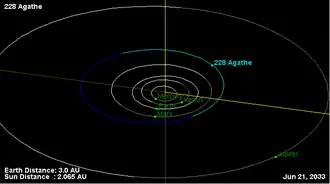228 Agathe
 Orbital diagram | |
| Discovery[1] | |
|---|---|
| Discovered by | J. Palisa |
| Discovery site | Vienna Observatory |
| Discovery date | 19 August 1882 |
| Designations | |
| (228) Agathe | |
Named after | daughter of astronomer Theodor v. Oppolzer[2] |
| A882 QA | |
| main-belt | |
| Orbital characteristics[1] | |
| Epoch 13 September 2023 (JD 2453300.5) | |
| Uncertainty parameter 0 | |
| Observation arc | 130.80 yr |
| Aphelion | 2.73 AU (408 million km) |
| Perihelion | 1.67 AU (250 million km) |
| 2.20 AU (329 million km) | |
| Eccentricity | 0.24227 |
| 3.27 yr (1193.1 d) | |
| 63.67° | |
| 0° 18m 6.408s / day | |
| Inclination | 2.5359° |
| 313.25° | |
| 19.177° | |
| Earth MOID | 0.657 AU (98.3 million km) |
| Mars MOID | 0.29 AU (43 million km) |
| Jupiter MOID | 2.63 AU (393 million km) |
| TJupiter | 3.624 |
| Physical characteristics | |
| Dimensions | 9.30±0.8 km |
| 6.484 h (0.2702 d) | |
| 0.2082±0.043 | |
| B–V = 0.918 U–B = 0.596 S (Tholen), S (SMASS) | |
| 12.32 | |
228 Agathe is a stony main belt asteroid, about 9 kilometers in diameter. It was discovered by Johann Palisa on 19 August 1882 at Vienna Observatory, Austria. Photometric observations during 2003 showed a rotation period of 6.48 ± 0.01 hours with a brightness variation of 0.27 ± 0.03 in magnitude. An earlier study yielded results that are consistent with these estimates.[3] Agathe is the lowest numbered asteroid to have an Earth-MOID as low as 0.657 AU (98.3 million km).[1] On 23 August 2029 the asteroid will be 0.659 AU (98.6 million km) from Earth.
| Date and time of closest approach | Earth distance (AU) | Sun distance (AU) | Velocity relative to Earth (km/s) | Velocity relative to Sun (km/s) | Uncertainty region (3-sigma) | Solar elongation |
|---|---|---|---|---|---|---|
| 23 August 2029 ≈07:22 | 0.6597 AU (98.69 million km; 61.32 million mi; 256.7 LD) | 1.67 AU (250 million km; 155 million mi) | 3.9 | 25.7 | ± 1.4 km | 177.9° |
Agathe was named after the youngest daughter of Austrian astronomer Theodor von Oppolzer (1841–1886), professor of astronomy in Vienna.[2]
References
- ^ a b c "JPL Small-Body Database Browser: 228 Agathe" (2023-08-05 last obs.). Jet Propulsion Laboratory. Retrieved 20 September 2023.
- ^ a b Schmadel, Lutz D. (2003). Dictionary of Minor Planet Names – (228) Agathe. Springer Berlin Heidelberg. p. 35. doi:10.1007/978-3-540-29925-7_229. ISBN 978-3-540-29925-7.
- ^ Cooney, Walter R. Jr. (March 2005), "Lightcurve results for minor planets 228 Agathe, 297 Caecilia, 744 Aguntina 1062 Ljuba, 1605 Milankovitch, and 3125 Hay", The Minor Planet Bulletin, 32 (1): 15–16, Bibcode:2005MPBu...32...15C.
- ^ "Horizons Batch for 228 Agathe on 2029-Aug-23" (Closest Earth approach occurs when deldot flips from negative to positive). JPL Horizons. Retrieved 20 September 2023.
External links
- Dictionary of Minor Planet Names, Google books
- The Asteroid Orbital Elements Database
- Minor Planet Discovery Circumstances
- 228 Agathe at AstDyS-2, Asteroids—Dynamic Site
- 228 Agathe at the JPL Small-Body Database